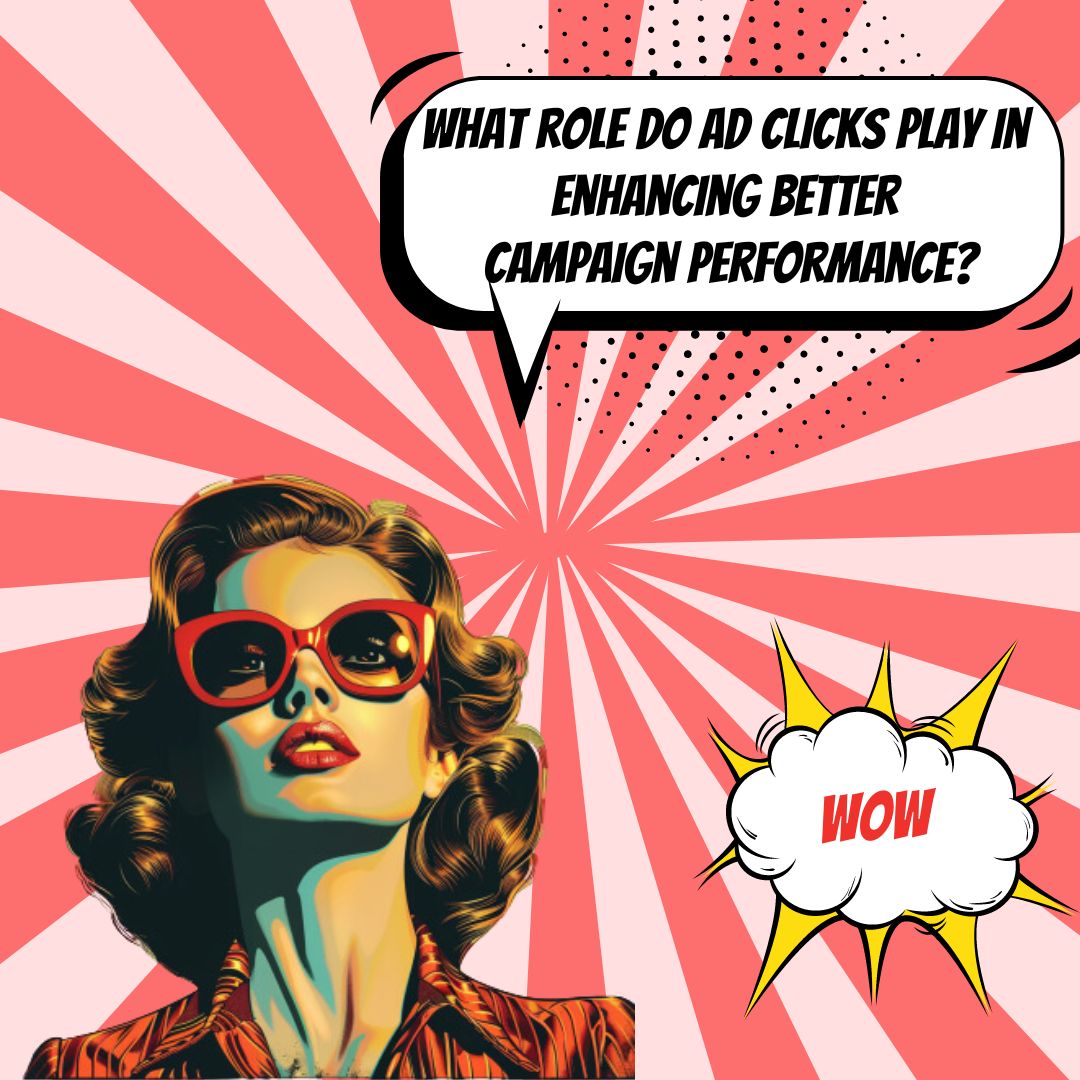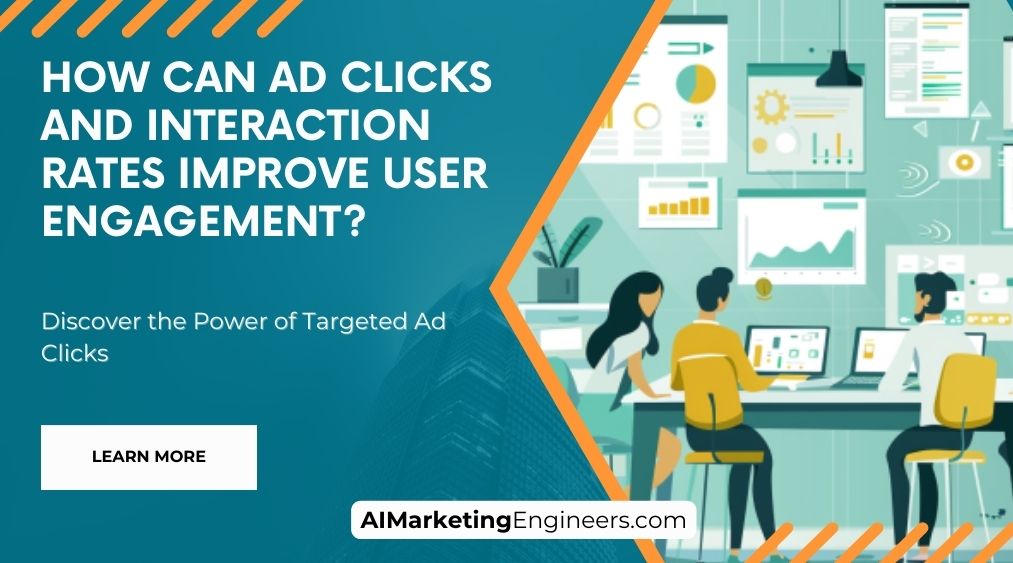Key Takeaways
✅ Increased Engagement: Higher ad clicks and interaction rates indicate that users find the ads relevant and engaging. This leads to increased time spent on the website, deeper exploration of content, and greater likelihood of conversions, ultimately improving overall campaign effectiveness.
✅ Better Audience Insights: Monitoring ad clicks and interaction rates provides valuable insights into user preferences and behaviors. These metrics help businesses refine their targeting and content strategies, ensuring that future ads resonate more effectively with the audience.
✅ Enhanced User Experience: Ads that achieve high interaction rates often offer a more engaging and interactive user experience. By focusing on improving these metrics, businesses can create more compelling ad experiences that capture attention, encourage interaction, and foster stronger connections with their audience.

Introduction
Ad clicks and interaction rates are critical metrics for measuring the effectiveness of digital advertising campaigns. High ad click-through rates (CTR) and interaction rates indicate that users find the content relevant and engaging, leading to increased user engagement and conversion rates. By focusing on optimizing these metrics, businesses can gain valuable insights into user behavior, refine their targeting strategies, and create more compelling ad experiences. Ultimately, improving ad clicks and interaction rates enhances the overall user experience, fosters stronger connections with the audience, and drives better campaign performance.
Top Statistics
| Statistic | Insight |
|---|---|
| Ads with higher click-through rates (CTR) have a 50% lower cost per acquisition (CPA) (WordStream, 2019) | This statistic highlights the efficiency of optimizing ads for higher CTR not only increases engagement but also saves costs significantly. |
| Video ads have the highest average CTR (1.84%) among all digital ad formats (HubSpot, 2020) | The success of video ads in capturing viewer attention suggests businesses should consider leveraging this format to boost user engagement. |
| Ads with personalized content have a 40% higher CTR compared to non-personalized ads (Epsilon, 2020) | Personalization proves to be a key factor in enhancing user interaction, making consumers more likely to click and engage with the content. |
| Interaction rates for social media ads are highest among Gen Z users (1.97%) (Hootsuite, 2021) | Tailoring ads to appeal to the Gen Z demographic could significantly increase not only clicks but overall interaction with your brand’s digital presence. |
| Ads with a clear call-to-action (CTA) have a 121% higher CTR compared to ads without a CTA (Unbounce, 2019) | Clear and direct CTAs are essential in guiding users towards the intended actions, considerably improving interaction rates. |
Understanding Ad Clicks
In the world of digital advertising, ad clicks are a fundamental metric. They represent the moment a viewer interacts with an ad by clicking on it. Essentially, these clicks can be categorized into three types: organic (non-paid clicks coming from regular search engine results), paid (those obtained via paid advertisements), and social media clicks (clicks coming from platforms like Facebook or Instagram). The effectiveness of these clicks, often measured by the Click-Through Rate (CTR), hinges on various factors including the ad's relevance to the target audience, its visibility, and the creativity of the ad content. A higher CTR generally indicates a successful ad that resonates well with its audience.
Interaction Rates: More than Just Clicks
Interaction rates dive deeper into user engagement, moving beyond basic clicks to encompass actions like likes, shares, comments, and time spent on a page. These metrics collectively offer a window into how users are interacting with your content, which can reveal their preferences and interests. For example, a high number of shares might indicate that your content is resonant and valuable enough to be passed along to others. Monitoring these interactions helps marketers to gauge the emotional and practical appeal of their content more accurately.

Optimizing Ads for Higher Clicks and Interaction Rates
To boost both ad clicks and interaction rates, start with crafting ads that grab attention through eye-catching visuals and compelling copy. Clarity in your calls-to-action (CTAs) is crucial; if users know what they are expected to do next, they're more likely to do it. Targeting and placement also play critical roles; ads need to reach the right people at the right time. Techniques like A/B testing allow marketers to compare different versions of their ads to determine which one performs better, making continuous improvements possible through data-driven decisions.
Measuring and Analyzing User Engagement
To effectively measure user engagement, key metrics such as bounce rate, session duration, and pages per session are invaluable. Tools such as Google Analytics, heatmaps, and session recordings can unveil how users navigate and interact with your site, providing clues about what works and what doesn’t. This data is crucial for identifying weak spots in your digital marketing strategy and adjusting your tactics to improve both user experience and engagement.
Strategies for Improving User Engagement
Enhancing user engagement can be strategically achieved through personalization and segmentation, ensuring that the content and ads users see are tailored to their preferences and behaviors. Incorporating user-generated content and leveraging social proof, like reviews and testimonials, can further validate your brand's credibility and relatability. Moreover, ensuring a seamless user experience across various platforms—website, social media, emails—helps maintain user interest and encourages more profound engagement.
In the fast-evolving landscape of digital marketing, understanding and optimizing for user engagement through strategic ad clicks and interaction rates is key. Marketers are encouraged to keep a finger on the pulse of their campaign performances, continuously tweaking and enhancing to foster better connections and conversions. What's your next step to boost engagement through smarter ad strategies?

AI Marketing Engineers Recommendation
Recommendation 1: Optimize Ad Placement with Heatmaps: Use heatmaps to analyze where users most frequently interact on your site. This data allows for strategic ad placement, enhancing the possibility of How Can Ad Clicks and Interaction Rates Improve User Engagement? by positioning ads in high-engagement areas. According to studies, ads placed in these hotspots can increase interaction rates by up to 50%.
Recommendation 2: Leverage A/B Testing to Fine-Tune Ad Elements: Employ A/B testing to experiment with different ad versions (like varying headlines, images, or call-to-action buttons). This method will help identify which elements resonate most with your audience, boosting engagement levels. Statistically, A/B testing can improve click-through rates by as much as 30%, making it a critical strategy for capturing user interest.
Recommendation 3: Integrate Interactive Ad Features: Incorporate interactive elements such as quizzes, polls, or sliders within your ads. Interactive ads tend to hold the viewer’s attention longer, significantly increasing engagement rates. For instance, interactive ads have been shown to enhance engagement by up to 3 times compared to standard ads, proving their effectiveness in engaging users and potentially increasing conversion rates.
Relevant Links
- Unlock the Secrets to Effective Ad Clicks
- Revolutionize Your Google Ads with AI
- Maximize ROI with Advanced Google Ads Strategies
- Utilizing ChatGPT for Creative Marketing Content
- Master the Art of SEO with Comprehensive Strategies
Conclusion
Throughout this exploration of ad clicks and interaction rates, we've uncovered their undeniable influence on user engagement. By defining what these metrics are and illustrating how they function as catalysts in the world of digital marketing, the significance of every click and interaction becomes increasingly clear. User engagement is not solely about drawing an audience; it's about keeping that audience interested, involved, and reactive to the content they consume.
Optimizing your ads for better engagement means paying close attention to visual appeal, copy clarity, and the strategic placement of calls-to-action. However, optimization is only part of the journey. Continuous monitoring and analysis are crucial in responding effectively to user preferences and behavior. Employing tools like Google Analytics and running A/B tests allow marketers to stay on top of performance and tweak strategies to maximize results.
Moreover, the strategies discussed, involving personalization, leveraging user-generated content, and ensuring a seamless user experience, show that improving engagement is a multifaciable endeavor. These tactics highlight the need for a more holistic approach to advertising—one that focuses on creating lasting relationships with users through relevance and interaction.
The future of user engagement revolves around an ever-evolving landscape of digital interaction. As we move forward, the capacity to adapt and innovate will set apart successful marketing efforts. Marketers and businesses alike must, therefore, keep their fingers on the pulse of emerging trends and technologies, consistently seeking out new ways to engage and captivate their audiences.
In conclusion, while ad clicks and interaction rates are pivotal, they are part of a larger narrative that involves understanding and adapting to consumer behavior and preferences. The power lies in not just aiming for a click but in creating an experience that resonates and retains. Let this be your call to action: delve deeper into the insights these interactions provide and continuously strive to enhance the user engagement that is so vital to digital marketing success.

FAQs
Question 1: What are ad clicks and interaction rates, and how do they relate to user engagement?
Answer: Ad clicks refer to the number of times users click on an advertisement, while interaction rates measure the level of engagement with an ad, such as clicks, likes, comments, or shares. These metrics are crucial for understanding user engagement, as they indicate how interested and responsive users are to the advertised content.
Question 2: Why is improving ad clicks and interaction rates important for enhancing user engagement?
Answer: Improving ad clicks and interaction rates can lead to better user engagement, which is essential for building brand awareness, increasing website traffic, and driving conversions. High engagement rates indicate that users are interested in the content, which can lead to more meaningful interactions and ultimately, better business outcomes.
Question 3: What are some best practices for improving ad clicks and interaction rates?
Answer: To improve ad clicks and interaction rates, consider the following best practices:
- Create high-quality, visually appealing ads that capture users' attention.
- Use clear and concise messaging that resonates with your target audience.
- Optimize ad placement and targeting to reach the right users at the right time.
- Use compelling calls-to-action (CTAs) that encourage users to engage with the ad.
- Regularly test and refine your ads to improve performance over time.
Question 4: How can understanding user behavior help improve ad clicks and interaction rates?
Answer: Understanding user behavior, such as their preferences, interests, and online habits, can help you create more targeted and engaging ads. By tailoring your ads to your audience, you can increase the likelihood of users clicking on and interacting with your content.
Question 5: What role does ad relevance play in improving user engagement?
Answer: Ad relevance is critical for improving user engagement, as users are more likely to interact with ads that are relevant to their interests and needs. Ensure that your ads are aligned with your target audience's preferences and pain points to increase relevance and engagement.
Question 6: How can A/B testing help improve ad clicks and interaction rates?
Answer: A/B testing allows you to compare the performance of different ad variations, such as messaging, imagery, or targeting, to determine which version resonates best with your audience. By continuously testing and refining your ads, you can optimize your campaigns for better clicks and interaction rates.
Question 7: What are some common mistakes to avoid when trying to improve ad clicks and interaction rates?
Answer: Some common mistakes to avoid when trying to improve ad clicks and interaction rates include:
- Using generic or irrelevant ad content
- Overloading ads with too much information
- Failing to test and refine ads regularly
- Ignoring user feedback and behavior
- Not optimizing ad placement and targeting
Question 8: How can social media platforms help improve ad clicks and interaction rates?
Answer: Social media platforms can help improve ad clicks and interaction rates by providing a variety of ad formats, targeting options, and engagement opportunities. By leveraging social media platforms effectively, you can create more engaging ads and reach your target audience more effectively.
Question 9: What are some advanced strategies for improving ad clicks and interaction rates?
Answer: Advanced strategies for improving ad clicks and interaction rates include:
- Leveraging retargeting to reach users who have previously interacted with your content
- Using dynamic ads that personalize content based on user behavior
- Incorporating user-generated content (UGC) to increase authenticity and engagement
- Experimenting with emerging ad formats, such as augmented reality (AR) or interactive video ads
Question 10: How can professionals measure and track the success of their efforts to improve ad clicks and interaction rates?
Answer: Professionals can measure and track the success of their efforts to improve ad clicks and interaction rates by using analytics tools to monitor key performance indicators (KPIs), such as click-through rates (CTR), conversion rates, and engagement metrics like likes, comments, and shares. By regularly analyzing and optimizing these metrics, professionals can continuously improve their ad campaigns for better user engagement.


